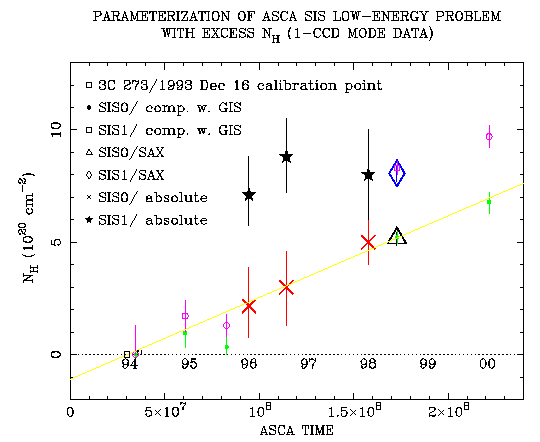Overall Relation Between the Low-Energy SIS Degradation and Time
All the measurements derived from methods 1-4 above are plotted together in Figure 5.

It can be seen that the SIS-0 data fit very well with a straight line but the SIS-1 data do not. It seems that both SIS-0 and SIS-1 underwent a dramatic degradation during 1995--1996 and that the gap between SIS-0 and SIS-1 diverged dramaticaly at the same time, and this was also indicated by the SIS-1/SIS-0 ratios (see Figure 3b). If we draw a straight line going through the 16 Decemeber 1993 point (3C 273 anchor) and the 24 June 1998 SIS-0 point (3C 273 simultaneous ASCA/BeppoSAX), it agrees with all the other SIS-0 calibration points extremely well. The equation of the straight line going through the SIS-0 data is
NH(SIS-0) = 3.635857508e-8(T-3.0174828e7) e20 cm-2
where T is ASCATIME (take the average of the start and stop times of your observation). The SIS-1 degradation with time cannot be modeled by a straight line. However, one can measure the SIS-1/SIS-0 ratio for the observation we are trying to correct, providied the signal-to-noise is sufficient. One measures the NH excess from the SIS-1/SIS-0 ratio and simply add this to the SIS-0 correction to correct the SIS-1 data. If the signal-to-noise is insufficient to measure the SIS-1/SIS-0 ratio, then attempting to correct either the SIS-0 or SIS-1 data is not useful anyway.
Previous: Absolute Mode-Independent Calibration Points
Next: Connection Between 1-CCD and 2-CCD Mode Data
Back: "SIS Low-Energy Degradation" Main Page
This file was last modified on Monday, 30-Jul-2001 18:17:25 EDT
Curator:
HEASARC Guest Observer Facility
If you have any questions concerning ASCA, visit our Feedback form.

